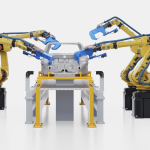
ADVANCED DATA ANALYTICS SERIES
Blueprints
In today’s rapidly evolving market landscape, real-time data analysis stands as a cornerstone for dynamic cost optimization within supply chain management. This blueprint delves into the criticality of integrating live data analytics to not only navigate but also thrive amidst the complexities and volatilities inherent in global supply chains. It addresses pressing challenges such as demand fluctuations, supply disruptions, and escalating operational costs.
By embracing real-time data analysis, supply chain directors can unlock unprecedented opportunities for cost reduction, efficiency enhancement, and strategic agility. The ensuing discussion outlines a comprehensive approach to leveraging cutting-edge technologies and methodologies, aiming to transform data into actionable insights for informed decision-making and sustainable competitive advantage.
Read the full blueprint below >>
The main objective is to empower decision-makers with actionable insights and methodologies that significantly enhance supply chain efficiency, reduce operational costs, and improve responsiveness to market fluctuations.
Key value propositions include a detailed step-by-step implementation guide that outlines actionable steps, essential tools, and technologies required, along with best-in-class examples. Furthermore, the blueprint addresses common challenges faced during implementation, offering practical solutions to overcome these hurdles effectively.
By integrating the insights and strategies detailed in this guide, supply chain leaders can anticipate not only significant improvements in operational performance and cost management but also position their organizations for a competitive advantage in the global marketplace.
At the heart of “Real-Time Data Analysis for Dynamic Cost Optimization” are two pivotal concepts that intertwine theory with practice: real-time data analysis and dynamic cost optimization. Understanding these concepts is crucial for supply chain directors to navigate the complexities of modern supply chains effectively.
Real-Time Data Analysis involves the continuous collection and processing of data as it becomes available, allowing businesses to make informed decisions instantaneously. In the context of supply chain management, this means having instant visibility into various facets of the supply chain, from inventory levels and warehouse capacity to transit times and market demand. The theoretical underpinning of real-time data analysis lies in information theory and computational analytics, which provide the foundation for developing algorithms and systems capable of handling large streams of data efficiently and effectively.
The practical application of real-time data analysis in supply chains is vast. It enables predictive analytics for demand forecasting, real-time tracking of goods and materials, and instant feedback mechanisms for supply chain performance. This immediacy transforms decision-making from a reactive to a proactive stance, where potential issues can be anticipated and mitigated before they escalate.
Dynamic Cost Optimization, on the other hand, refers to the ability to adjust and optimize costs dynamically in response to real-time data insights. Theoretically, it draws from principles of economics, operations research, and systems engineering, focusing on optimizing complex systems in variable conditions. Practically, it involves strategies like dynamic pricing, where prices adjust in response to market demand; just-in-time inventory management, which reduces holding costs by synchronizing production with demand; and optimized routing, which minimizes logistics costs by adapting routes in real-time to avoid delays and disruptions.
Integrating these concepts requires a robust framework that supports data ingestion, analysis, and actionable output. This involves setting up an ecosystem of IoT devices and sensors for data collection, cloud computing for data storage and processing, and advanced analytics software that employs machine learning and AI to interpret data and suggest optimizations. The outcome is a supply chain that not only adapts in real-time to internal and external stimuli but also continuously evolves to optimize costs, thereby enhancing overall efficiency and competitiveness.
Implementing real-time data analysis for dynamic cost optimization in supply chain operations requires adherence to several best practices. These practices ensure that the integration of real-time data into decision-making processes not only enhances operational efficiency but also drives significant cost reductions.
- Establish a Comprehensive Data Infrastructure: The foundation of real-time data analysis is a robust data infrastructure. Supply chain operations should be equipped with IoT devices and sensors across all touchpoints, from warehouses and distribution centers to transportation vehicles. For instance, installing sensors in warehouses to monitor inventory levels in real-time can prevent stockouts and overstocking, optimizing inventory holding costs.
- Leverage Cloud Computing and Edge Computing: Utilizing cloud computing allows for scalable data storage and processing capabilities, essential for handling vast amounts of real-time data. Edge computing can be employed to process data closer to its source, reducing latency and accelerating decision-making processes. A hypothetical scenario could involve using edge computing in fleet vehicles to analyze data on traffic conditions and reroute in real-time, minimizing fuel costs and delivery delays.
- Implement Advanced Analytics and AI: Applying machine learning algorithms and AI to analyze the collected data can unveil patterns and insights that would be impossible to discern manually. For example, machine learning models can predict demand spikes based on historical data and current market trends, allowing for dynamic adjustments in production schedules and inventory levels.
- Develop Dynamic Pricing Models: Dynamic pricing adjusts prices in real-time based on demand, competition, and other external factors. Retailers, for instance, can use real-time data on consumer behavior and competitor pricing to adjust their prices dynamically, maximizing margins while staying competitive.
- Foster a Culture of Agility and Continuous Improvement: Embedding a culture that values agility and continuous improvement is crucial. Teams should be encouraged to use real-time data insights to experiment with new strategies, learn from outcomes, and iteratively refine processes.
By adhering to these best practices, supply chain operations can harness the full potential of real-time data analysis for dynamic cost optimization, turning data into a strategic asset that drives operational excellence and competitive advantage.
Implementing real-time data analysis for dynamic cost optimization is a structured process involving several critical steps, each broken down into actionable sub-steps for clarity and effectiveness.
Step 1: Assess Current Capabilities and Define Objectives
- Actions:
- Audit existing supply chain processes, data systems, and analytics capabilities.
- Identify gaps and areas for improvement.
- Set specific, measurable objectives for real-time data analysis implementation.
Step 2: Develop a Data Management Strategy
- Actions:
- Establish data collection protocols.
- Define data storage, processing, and governance policies.
- Ensure data quality and security measures are in place.
Step 3: Set Up Real-Time Data Collection Mechanisms
- Actions:
- Install IoT devices and sensors at critical points in the supply chain.
- Ensure real-time data transmission capabilities are established.
- Validate the accuracy and reliability of the collected data.
Step 4: Implement Cloud and Edge Computing Infrastructure
- Actions:
- Deploy cloud computing for scalable data storage and analytics.
- Utilize edge computing for low-latency data processing at the source.
- Ensure seamless integration between cloud and edge computing environments.
Step 5: Integrate Advanced Analytics and AI
- Actions:
- Develop and train machine learning models for predictive analytics.
- Apply AI algorithms for real-time decision-making and optimization.
- Continuously update and refine models based on new data and insights.
Step 6: Develop Dynamic Decision-Making Frameworks
- Actions:
- Establish decision-making models that leverage real-time data insights.
- Implement dynamic pricing and inventory management systems.
- Facilitate scenario planning and simulations for strategic decisions.
Step 7: Implement Real-Time Monitoring and Feedback Systems
- Actions:
- Set up real-time dashboards and alerts for critical supply chain metrics.
- Establish feedback loops for continuous process improvement.
- Encourage data-driven decision-making culture across the organization.
Step 8: Train and Empower Your Team
- Actions:
- Conduct comprehensive training on real-time data analysis tools and processes.
- Foster a culture that values data-driven insights and continuous learning.
- Create cross-functional teams to bridge the gap between IT and supply chain operations.
Step 9: Pilot and Scale
- Actions:
- Initiate a pilot project to test the real-time data analysis system in a controlled setting.
- Evaluate the pilot’s outcomes and refine the approach based on feedback.
- Gradually scale the successful practices across the organization.
Step 10: Continuous Improvement and Adaptation
- Actions:
- Implement a continuous improvement process to regularly evaluate and enhance the system.
- Stay informed about new technologies and industry trends to adapt and innovate.
- Encourage feedback and ideas from all levels of the organization to drive improvement.
By following these detailed steps, organizations can effectively implement real-time data analysis for dynamic cost optimization, ensuring their supply chain operations are efficient, responsive, and strategically aligned with business goals.
IoT Devices and Sensors
Features: IoT devices and sensors can monitor various parameters in real time, such as location, temperature, humidity, and movement, providing a constant stream of data from every link in the supply chain.
Benefits: They offer unparalleled visibility into the supply chain, allowing for immediate responses to disruptions or changes in demand. This visibility is crucial for maintaining inventory at optimal levels and reducing waste.
Integration: These devices are the foundational layer of real-time data collection (Step 3), feeding data into analytics platforms for processing and analysis.
Cloud and Edge Computing
Features: Cloud computing provides scalable storage and powerful computing resources on demand, while edge computing processes data closer to its source, reducing latency.
Benefits: This combination allows for the efficient handling of vast amounts of data while enabling quick, local decision-making where necessary, such as in automated quality control or immediate rerouting of logistics in response to disruptions.
Integration: Deployed in Step 4, these technologies support the backbone of real-time analytics, ensuring data is processed and analyzed promptly and cost-effectively.
Data Analytics Platforms
Features: Advanced analytics platforms capable of processing big data sets in real-time, applying machine learning models, and generating actionable insights.
Benefits: They enable predictive analytics for demand forecasting, identify cost-saving opportunities, and optimize inventory management, leading to significant cost reductions and improved efficiency.
Integration: In Step 5, these platforms are crucial for turning raw data into actionable insights, enabling dynamic decision-making based on current conditions.
Dynamic Pricing and Inventory Management Systems
Features: These systems use real-time data to adjust prices and inventory levels dynamically, based on current market conditions, demand forecasts, and supply chain statuses.
Benefits: They help maintain optimal stock levels, reduce holding costs, and maximize profitability through price optimization.
Integration: Implemented in Step 6, these systems directly leverage insights from real-time data analysis to make cost-effective operational decisions.
Dashboards and Visualization Tools
Features: These tools provide real-time monitoring of key performance indicators (KPIs) and critical metrics through intuitive interfaces.
Benefits: They enable immediate visibility into the supply chain’s performance, facilitating quick decision-making and highlighting areas needing attention.
Integration: Utilized in Step 7, dashboards are essential for disseminating real-time insights across the organization, ensuring that decision-makers have the information they need at their fingertips.
Incorporating these tools and technologies into the supply chain infrastructure allows companies to harness the power of real-time data for dynamic cost optimization, making their operations more agile, efficient, and competitive.
For supply chain directors, measuring the success of real-time data analysis initiatives in achieving cost optimization involves tracking specific Key Performance Indicators (KPIs). These metrics not only reflect the effectiveness of real-time analytics but also guide continuous improvement efforts.
Cost Reduction Percentage
Definition: Measures the percentage reduction in operational costs (production, logistics, inventory holding, etc.) as a direct result of implementing real-time data analysis.
Tracking: Compare current operational costs with baseline costs prior to implementation over a consistent period. Use financial management software to aggregate and analyze cost data.
Interpretation: A significant reduction indicates successful cost optimization. Investigate areas with minimal change for further improvement opportunities.
Inventory Levels and Turnover
Definition: Inventory levels track the amount of stock held, while turnover rates measure how quickly inventory is sold and replaced over a period.
Tracking: Use inventory management systems to monitor real-time inventory levels and calculate turnover rates by dividing the cost of goods sold by the average inventory value.
Interpretation: Optimal inventory levels and higher turnover rates suggest efficient stock management, reduced holding costs, and responsiveness to demand changes.
Order Fulfillment Cycle Time
Definition: The time taken from receiving an order to delivering the product to the customer.
Tracking: Leverage logistics and supply chain management software to record and analyze the timeframes of each order fulfillment stage.
Interpretation: Shorter cycle times imply efficient processes and improved customer satisfaction, indicating effective real-time optimizations in logistics and supply chain operations.
Supply Chain Cost as a Percentage of Sales
Definition: This metric compares the total cost of supply chain operations to the total sales revenue.
Tracking: Financial and supply chain analytics tools can help quantify this ratio by correlating sales data with supply chain expenses.
Interpretation: A lower ratio suggests that the company is achieving cost optimization while maintaining or increasing sales, highlighting the positive impact of real-time data analysis on the bottom line.
By monitoring these KPIs, supply chain directors can quantitatively assess the impact of real-time data analysis on cost optimization, allowing for informed strategic decisions and highlighting areas for further improvement.
Tab content




